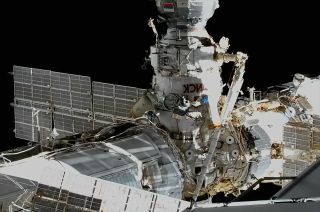Spacewalkers configure new space station robotic arm on rare Russian-European EVA
Oleg Artemyev and Samantha Cristoforetti completed a 7 hour spacewalk outside of the International Space Station Thursday (July 21).

A Russian cosmonaut and an Italian astronaut worked together outside of the International Space Station Thursday (July 21), marking the first time in almost a quarter century that a European participated in a Russian-operated spacewalk.
Expedition 67 crewmates Oleg Artemyev of Russia's federal space corporation Roscosmos and Samantha Cristoforetti of the European Space Agency (ESA) spent 7 hours and 5 minutes further configuring a new robotic arm for the Russian segment of the space station, and hand deploying a series of small satellites.
Cristoforetti has now become the fourth ESA astronaut and first European woman to perform a spacewalk wearing a Russian Orlan spacesuit.
Working about an hour behind schedule — the two were about 50 minutes late to exit the airlock on the Poisk module at 10:50 a.m. EDT (1450 GMT) — Artemyev and Cristoforetti were still able to complete all but one of the goals planned for the excursion.
The first task for the two were to release into orbit 10 nanosatellites as part of a radio technology experiment. After setting up their tools and removing protective covers — two featuring the image the satellites' namesake, Soviet-era rocket pioneer Konstantin Tsiolkovsky — Artemyev gently tossed each CubeSat overboard.
"I see the Earth and deploy in progress," reported the cosmonaut as he released the first of the satellites, through English-language interpretation provided by the broadcast. "There it goes."
Artemyev and Cristoforetti then mounted a temporary platform that will used by the new European Robotic Arm (ERA) installed on an earlier spacewalk. This was performed to move an airlock that was launched with the Rassvet mini-research module to its permanent position on the Nauka multipurpose laboratory module.
Get the Space.com Newsletter
Breaking space news, the latest updates on rocket launches, skywatching events and more!
Built and provided by ESA, the 37-foot-long (11-m) ERA manipulator will be used to move payloads and equipment outside of the Russian segment of the space station, joining the Canadian-built Canadarm2 robotic arm and the Japanese Kibo arm already supporting station maintenance, operations and research.
Artemyev and Cristoforetti next installed a payload adaptor on the Nauka module. The fixture will be used to hold payloads and tools to assist future spacewalks.
Artemyev then worked to prepare the robotic arm's external control panel to be relocated by placing it into a storage or hibernation mode. The External Man Machine Interface (EMMI) will allow future spacewalkers to move and position the arm from outside of the space station, a feature unique to the ERA.
Cristoforetti, meanwhile, worked on the replacement of a protective cover on one the two identical camera light units located on either end of the two end effectors, or hands, on the ERA. The replacement cover will improve the acuity of the camera.
The two crewmates were then supposed to extend a Strela telescoping boom from the Zarya service module to the Poisk mini-research module to facilitate future spacewalks, but the activity was deferred.
"Because for the lack of time, we are terminating early," Russian mission control advised the spacewalkers. "We are terminating because of the spacesuit life support system constraints."

Artemyev and Cristoforetti re-entered the Poisk airlock and closed the hatch at 5:55 p.m. EDT (2155 GMT).
Thursday's spacewalk was the sixth for the year and 251st supporting the assembly, upgrade and maintenance of the International Space Station since 1998.
This was the sixth EVA for Artemyev, who now has logged 41 hours and 44 minutes working the vacuum of space. In addition to her other records set, Cristoforetti is also the first European to conduct a Russian spacewalk outside of the International Space Station.
The previous three ESA astronauts to wear an Orlan spacesuit — Jean-Loup Chrétien, Thomas Reiter and Jean-Pierre Haigneré — did so at the former Russian Mir space station. Other European astronauts have conducted spacewalks in U.S. spacesuits.
Cristoforetti is also only the second woman to conduct a Russian spacewalk, after NASA astronaut Peggy Whitson in 2002. Thursday's EVA was the first international spacewalk to use Orlan spacesuits in 13 years.
Follow collectSPACE.com on Facebook and on Twitter at @collectSPACE. Copyright 2022 collectSPACE.com. All rights reserved.
Join our Space Forums to keep talking space on the latest missions, night sky and more! And if you have a news tip, correction or comment, let us know at: community@space.com.

Robert Pearlman is a space historian, journalist and the founder and editor of collectSPACE.com, an online publication and community devoted to space history with a particular focus on how and where space exploration intersects with pop culture. Pearlman is also a contributing writer for Space.com and co-author of "Space Stations: The Art, Science, and Reality of Working in Space” published by Smithsonian Books in 2018. He previously developed online content for the National Space Society and Apollo 11 moonwalker Buzz Aldrin, helped establish the space tourism company Space Adventures and currently serves on the History Committee of the American Astronautical Society, the advisory committee for The Mars Generation and leadership board of For All Moonkind. In 2009, he was inducted into the U.S. Space Camp Hall of Fame in Huntsville, Alabama. In 2021, he was honored by the American Astronautical Society with the Ordway Award for Sustained Excellence in Spaceflight History.
